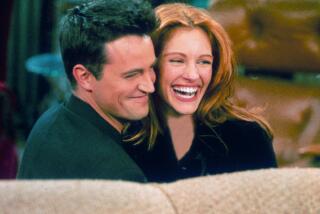‘Upstairs, Downstairs,’ the occupants move back in
Reporting from New York — — Pity the British: When it comes to etiquette, they’re always getting their petticoats all in a bunch.
Take the very proper Londoners on “Upstairs, Downstairs,” the English period drama that helped “Masterpiece Theatre” forge its reputation during the 1970s. When the series returns to PBS on April 10, it’s a perfect English day during the Depression — gray and overcast — and yet the head of the housekeeping staff, Rose Buck, seems quite ill at ease. The wrong type of marmalade has been ordered for the pet monkey. The maid has been forced to unpack a suitcase full of shabby knickers. And somebody has invited a Nazi to dinner. The lady of the house will be ruined! Ruined, we say!
Yes, England’s premier showcase for good manners is back, and for those who find there aren’t enough dour servants or tiny, crust-free cucumber sandwiches on TV, it’s still essential viewing. Over the last four decades, “Upstairs, Downstairs” has been watched by more than 1 billion people in more than 40 countries, inspiring a whole new generation of period dramas, including the recent PBS series “Downton Abbey.” (Just in case you’ve missed it, an “Upstairs, Downstairs” box set, due to be released on March 29, offers a chance to catch up with the first five seasons.)
Now, for the first time since it went off the air in 1977, the series will debut three new episodes (with more to follow in 2012), providing a long-awaited coda to the original, which followed London’s aristocratic Bellamy family and their below-stairs help from the pre-World War I era to the 1930 market crash.
Co-produced by the BBC and “Masterpiece” on PBS, the latest “Upstairs, Downstairs” picks up in 1936 with an all-new cast joining the series’ creator and star Jean Marsh, who plays Rose once again. A new couple has moved into 165 Eaton Place, and they need Rose, who’s now the proprietor of a domestic employment agency, to help them hire servants. Slowly, the outside world seeps into their self-contained universe, as the abdication crisis of Edward VIII and the rise of fascism on the continent begins to affect the family inside.
The timing couldn’t be better for this 1930s throwback. Just as viewers of the Depression escaped into the elegant romances of Fred Astaire and Ginger Rogers, there’s nothing like a recession to reignite Americans’ interest in a world of mink stoles, fine china and personal chefs. And now that “The King’s Speech” has swept the Oscars and the royal wedding has nabbed all our tabloid covers, British high society has piqued our interest again.
“It’s a perennially attractive idea,” says Rebecca Eaton, who executive produced “Upstairs, Downstairs” and many other popular “Masterpiece” series, including “Miss Marple.” Eaton admits that she has high hopes for the remake, which aired in the U.K. late last year to mostly positive (or at least wryly amused) reviews. “In times of great social and political uncertainty, aspirational stories always work, and ‘Upstairs, Downstairs’ is a very aspirational story.”
That wasn’t always the intention. Today it plays like luxury-home porn, with a plush leopard skin draped across every Chesterfield sofa, but Marsh and her co-creator Eileen Atkins originally envisioned the series as an up-with-the-working-class drama that focused entirely on the servants.
Marsh, like Atkins, came from a family of laborers. The idea for the series was even inspired by a photograph of one of Atkins’ relatives standing with a group of servants at a bus stop. “They looked like they were going on a day’s outing,” Marsh recalls. She and Atkins found themselves imagining a secret life for these servants. “There was just a sense of how exciting it must have been for her to go away, even 10 or 15 miles away, from wherever she was.”
But writer and script editor Alfred Shaughnessy, an aristocrat himself, pointed out that the below-stairs crowd had to serve someone, simply for dramatic friction. So the focus began to shift to the elite, creating class tension both on and off screen. While filming the first season, the cameramen went on strike, claiming they weren’t paid enough for the effort required to shoot in color. No one got a raise, and the crew ended up filming the first season in black and white.
Lesley-Anne Down, who played the spoiled Lady Georgina, remembers that the cast members weren’t compensated too well either. At the time, she and her boyfriend were forced to move into low-income housing. “One of the terms of [the] lease was that we had to take turns scrubbing the stairs,” Down recalls, laughing. “I used to do it at midnight when I knew nobody could see me. Here I was, a famous actress, going to premiere parties, and I couldn’t show anyone where I lived. The limo driver would take me home, and I’d say, ‘The best thing for you to do is park at the bottom of the hill.’ And then I’d walk all the way up that hill in high heels and an evening dress in the rain. It was ghastly!”
Between takes, the cast often found it difficult to shake the class they’d been assigned: The “upstairs” cast went out for drinks together, as did the “downstairs” cast. When the food arrived from Fortnum & Mason, the same upscale grocery store that serves Buckingham Palace, actor Gordon Jackson, who played Hudson the butler, would often rise to serve tea to his cohorts.
“We just did these things out of habit,” Marsh says. She remembers a scene in which she was supposed to offer a coat to Miss Elizabeth, played by Nicola Pagett, who would throw it on the floor. “Each time the director would say, ‘Let’s do it again,’ I would pick the coat up,” Marsh recalls. “Finally I said, ‘Wait a minute! I’m not really your bloody servant! Pick it up yourself!’”
Of course, part of what made “Upstairs, Downstairs” such a massive success was that its political tensions so closely mirrored those of the 1970s, the era in which it was produced. The first two seasons were decidedly progressive, as the Bellamy family faced falling living standards, a widening generation gap and a sharpening awareness of social inequalities, especially between upper-class men and lower-class women.
“The servants were initially given real characters and their back stories fully developed — they were treated as equals with those upstairs,” says Steven Fielding, a professor of political history at the University of Nottingham. But Fielding and others have argued that as England grew more conservative, the show followed suit, and by the final season, the series seemed to reinforce paternalistic politics, with servants and masters united in one happy “family.”
The remake, Fielding says, “has started where the original series ended — it degenerated into an upper-class soap with a primary focus on upstairs and the servants presented in more one-dimensional ways.” Fielding points out that while the remake is set during the Depression, the economy doesn’t seem to affect any of the “upstairs” characters.
But in America’s so-called class-free society, the show has a different appeal. Over the last half-decade, we’ve moved in the direction of Twitter and TMZ, toward the supremely boring idea that rich people are just like us. The real thrill of “Upstairs, Downstairs” is the outdated idea that society folks might still have secrets, and their whole lives depend on keeping them. Scandalous secrets, like baby-stealing and parlor-maid-impregnating and Nazi-sympathizing. It’s a world where simply getting caught with your shabby knickers down could change your social status forever — and not in a good way.
Looking back on that time, it’s hard not to feel sorry for those poor saps whose sins could get them kicked out of fancy ballrooms and cricket fields for the rest of eternity. Maybe that’s why the show remains so captivating here in America: We still believe that class is something that people can control, that if we just work hard enough, we can move our way up and out of one class and into another. There’s also a sense that simply watching “Upstairs, Downstairs” can make you just slightly more posh.
“Taste has become universal,” Marsh says. “And money doesn’t buy you taste.”
More to Read
The biggest entertainment stories
Get our big stories about Hollywood, film, television, music, arts, culture and more right in your inbox as soon as they publish.
You may occasionally receive promotional content from the Los Angeles Times.










